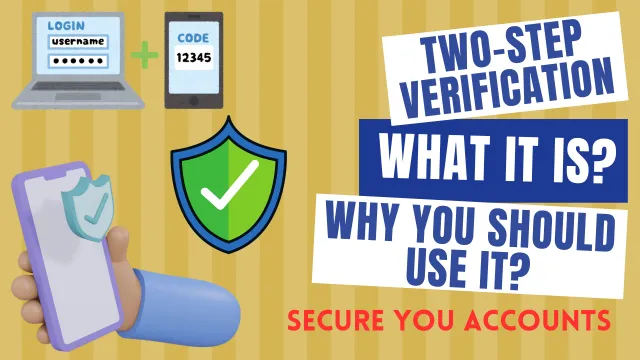Two-Step Verification: What It Is and Why You Should Use It?
In the era of ever-advancing technology, the need for robust online security measures has never been more apparent. As cyber threats continue to evolve, individuals and businesses alike must prioritize safeguarding their digital assets. One such essential tool in the cybersecurity arsenal is Two-Step Verification (2SV). In this article, we’ll lean bout Two-Step Verification: What It Is and Why You Should Use It? Also, why incorporating it into your online practices is crucial for enhancing your digital security.

Understanding Two-Step Verification
Two-Step Verification, also known as two-factor authentication (2FA) or multi-factor authentication (MFA), is a security process that requires users to provide two different authentication factors before gaining access to an account or system. This additional layer of security goes beyond the traditional username and password combination, offering a more robust defense against unauthorized access.
Knowledge Factor
The first step typically involves something you know, such as your password or a Personal Identification Number (PIN). This is the information you usually enter when logging into your account.
Possession Factor
The second step introduces something you have, like a mobile device or a hardware token. After entering your password, a unique code is sent to your device or generated by an authentication app. This code, often valid for a short period, serves as the second authentication factor.
Why You Should Use Two-Step Verification?
Enhanced Security
The primary purpose of Two-Step Verification is to bolster security by adding an extra layer of defense. Even if malicious actors manage to obtain your password, they will still need the second authentication factor to gain access, significantly reducing the risk of unauthorized entry.
Mitigating Password Vulnerabilities
Passwords, no matter how complex, can be vulnerable to various threats such as phishing, brute force attacks, or data breaches. Two-Step Verification acts as a safety net, minimizing the impact of compromised passwords by requiring an additional layer of authentication.

Protecting Personal and Financial Information
Many online platforms and services, including email, banking, and social media accounts, contain sensitive personal and financial information. Enabling Two-Step Verification ensures that only authorized individuals can access and modify these critical details, safeguarding your digital identity.
Securing Business Accounts
For businesses, the stakes are higher, with potential consequences ranging from financial loss to reputational damage in the event of a security breach. Implementing 2FA for business accounts adds an extra level of protection, reducing the risk of unauthorized access to sensitive corporate information.
Compliance Requirements
In some industries, regulatory standards mandate the use of multi-factor authentication to ensure data security and compliance. Adhering to these standards not only protects your organization but also ensures legal compliance.
2 Factor Authentication System from popular service providers
Conclusion
In an age where digital interactions are an integral part of daily life, safeguarding your online presence is non-negotiable. Two Step Verification emerges as a powerful and accessible tool that empowers individuals and organizations to fortify their digital defenses. By embracing this additional layer of security, you not only protect your sensitive information but also contribute to the collective effort to create a safer digital environment. Take the first step towards a more secure online experience—enable Two Step Verification today.
Suggested Reading:
- Two-Step Verification: What It Is and Why You Should Use It?
- How to Pair Apple Watch to New Phone?
- How to open BIOS Windows 11 | A Step-by-Step Guide
- How To Remotely Logoff disconnected Users via Command Line?
- How to get into Cyber Security? A Guide on How to Get Started
- MacBook Air Used | A Guide to Buying a Used MacBook Air
- How to make Google Chrome Dark Mode: Embrace the Dark Side
- NVMe Storage vs. SSD: Unveiling the Future of Storage Technology
- How to Change Name on iPhone Bluetooth: A Step-by-Step Guide
- 10 Best Free AI Tools Online: Unleashing Innovation and Productivity
- How to Turn On Apple Watch While Charging
- How to Turn Off Apple Watch 8
- How to Factory Reset MacBook Air Without Password
- How to Connect Two AirPods to MacBook
- How to Turn Off iPhone 14 : A Comprehensive Guide
- A Comprehensive Guide on How to Restart Apple Watch

